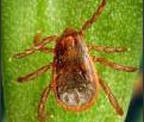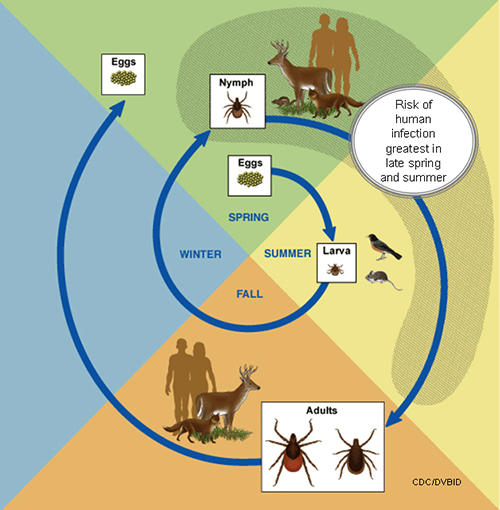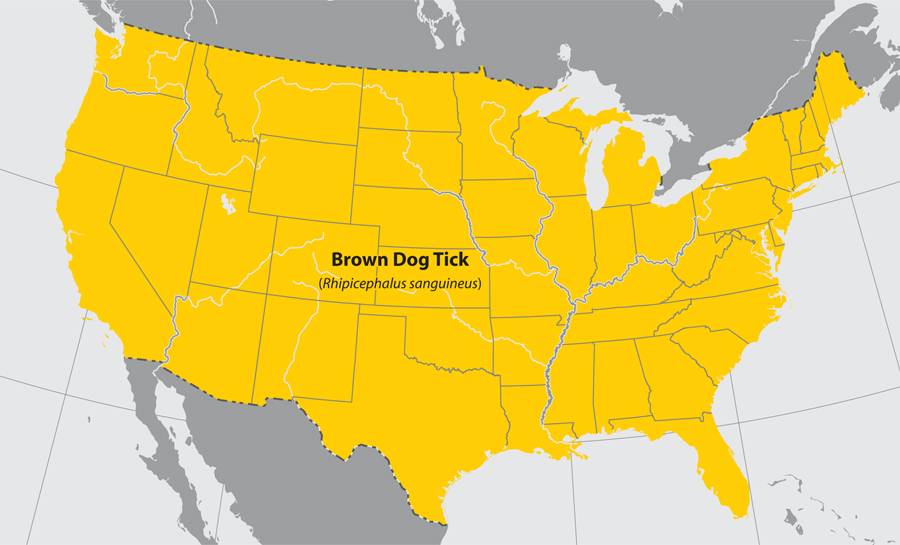Rhipicephalus sanguineus: Difference between revisions
Gerald Chi- (talk | contribs) (Created page with "{{Taxobox | name = ''Rhipicephalus sanguineus'' | image = Rhipicephalus sanguineus.jpg | image_alt = Rhipicephalus sanguineus | regnum = Animalia | phylum = Arthropoda...") |
No edit summary |
||
| Line 19: | Line 19: | ||
==Overview== | ==Overview== | ||
The '''brown dog tick''', '''''Rhipicephalus sanguineus''''', is a species of [[tick]] which is found worldwide, but more commonly in warmer climates. This species is unusual among ticks in that its entire [[biological life cycle|life cycle]] can be completed indoors.<ref name="lord">{{cite web |author=C. C. Lord |url=http://entomology.ifas.ufl.edu/creatures/urban/medical/brown_dog_tick.htm |title=Brown dog tick, ''Rhipicephalus sanguineus'' Latreille |work=Featured Creatures |publisher=[[University of Florida]] |date=2001 |accessdate=October 14, 2008}}</ref> | The '''brown dog tick''', '''''Rhipicephalus sanguineus''''', is a species of [[tick]] which is found worldwide, but more commonly in warmer climates. This species is unusual among ticks in that its entire [[biological life cycle|life cycle]] can be completed indoors.<ref name="lord">{{cite web |author=C. C. Lord |url=http://entomology.ifas.ufl.edu/creatures/urban/medical/brown_dog_tick.htm |title=Brown dog tick, ''Rhipicephalus sanguineus'' Latreille |work=Featured Creatures |publisher=[[University of Florida]] |date=2001 |accessdate=October 14, 2008}}</ref> | ||
==Life Cycle== | |||
====General Tick Life Cycle==== | |||
[[Image:Lifecycle.jpg|left|thumb| This image displays an example of the tick lifecycle, based on stages and the months that they are most likely to occur during.]] | |||
*A tick's life cycle is composed of four stages: ''hatching'' (egg), ''nymph'' (six legged), ''nymph'' (eight legged), and an ''adult''. | |||
*Ticks require blood meal to survive through their life cycle. | |||
*Hosts for tick blood meals include mammals, birds, reptiles, and amphibians. Ticks will most likely transfer between different hosts during the different stages of their life cycle. | |||
*Humans are most often targeted during the nymph and adult stages of the life cycle. | |||
*Life cycle is also dependent on seasonal variation. | |||
*Ticks will go from eggs to larva during the summer months, infecting bird or rodent host during the larval stage. | |||
*Larva will infect the host from the summer until the following spring, at which point they will progress into the nymph stage. | |||
*During the nymph stage, a tick will most likely seek a mammal host (including humans). | |||
*A nymph will remain with the selected host until the following fall at which point it will progress into an adult. | |||
*As an adult, a tick will feed on a mammalian host. However unlike previous stages, ticks will prefer larger mammals over rodents. | |||
*The average tick life cycle requires three years for completion. | |||
**Different species will undergo certain variations within their individual life cycles. <ref name="LCT CDC”">Life Cycle of Ticks that Bite Humans (2015). http://www.cdc.gov/ticks/life_cycle_and_hosts.html Accessed on December 30, 2015</ref> | |||
<br> | |||
<br> | |||
<br> | |||
<br> | |||
'''Spread of Tick-borne Disease''' | |||
*Ticks require blood meals in order to progress through their life cycles. | |||
*The average tick requires 10 minutes to 2 hours when preparing a blood meal. | |||
*Once feeding, releases anesthetic properties into its host, via its saliva. | |||
*A feeding tube enters the host followed by an adhesive-like substance, attaching the tick to the host during the blood meal. | |||
*A tick will feed for several days, feeding on the host blood and ingesting the host's pathogens. | |||
*Once feeding is completed, the tick will seek a new host and transfer any pathogens during the next feeding process. <ref name="LCT CDC”">Life Cycle of Ticks that Bite Humans (2015). http://www.cdc.gov/ticks/life_cycle_and_hosts.html Accessed on December 30, 2015</ref> | |||
==Hosts== | ==Hosts== | ||
Revision as of 14:42, 16 February 2016
| style="background:#Template:Taxobox colour;"|Rhipicephalus sanguineus | ||||||||||||||||
|---|---|---|---|---|---|---|---|---|---|---|---|---|---|---|---|---|
 | ||||||||||||||||
| style="background:#Template:Taxobox colour;" | Scientific classification | ||||||||||||||||
| ||||||||||||||||
| Binomial name | ||||||||||||||||
| Rhipicephalus sanguineus (Latreille, 1806) |
Editor-In-Chief: C. Michael Gibson, M.S., M.D. [1]
Overview
The brown dog tick, Rhipicephalus sanguineus, is a species of tick which is found worldwide, but more commonly in warmer climates. This species is unusual among ticks in that its entire life cycle can be completed indoors.[1]
Life Cycle
General Tick Life Cycle

- A tick's life cycle is composed of four stages: hatching (egg), nymph (six legged), nymph (eight legged), and an adult.
- Ticks require blood meal to survive through their life cycle.
- Hosts for tick blood meals include mammals, birds, reptiles, and amphibians. Ticks will most likely transfer between different hosts during the different stages of their life cycle.
- Humans are most often targeted during the nymph and adult stages of the life cycle.
- Life cycle is also dependent on seasonal variation.
- Ticks will go from eggs to larva during the summer months, infecting bird or rodent host during the larval stage.
- Larva will infect the host from the summer until the following spring, at which point they will progress into the nymph stage.
- During the nymph stage, a tick will most likely seek a mammal host (including humans).
- A nymph will remain with the selected host until the following fall at which point it will progress into an adult.
- As an adult, a tick will feed on a mammalian host. However unlike previous stages, ticks will prefer larger mammals over rodents.
- The average tick life cycle requires three years for completion.
- Different species will undergo certain variations within their individual life cycles. [2]
Spread of Tick-borne Disease
- Ticks require blood meals in order to progress through their life cycles.
- The average tick requires 10 minutes to 2 hours when preparing a blood meal.
- Once feeding, releases anesthetic properties into its host, via its saliva.
- A feeding tube enters the host followed by an adhesive-like substance, attaching the tick to the host during the blood meal.
- A tick will feed for several days, feeding on the host blood and ingesting the host's pathogens.
- Once feeding is completed, the tick will seek a new host and transfer any pathogens during the next feeding process. [2]
Hosts
Rhipicephalus sanguineus will feed on a wide variety of mammals, but dogs are the preferred host in the U.S., and the population can reach pest proportions in houses and kennels.[1]
Medical importance
R. sanguineus is one of the most important vectors of diseases in dogs worldwide.[3] In the United States, R. sanguineus is a vector of the diseases in dogs: canine ehrlichiosis (Ehrlichia canis) and canine babesiosis (Babesia canis). In dogs, symptoms of canine ehrlichiosis include lameness and fever; those for babesiosis include fever, anorexia and anemia. R. sanguineus has not been shown to transmit the bacteria which causes Lyme disease in humans.[1] In parts of Europe, Asia and Africa, it is a vector of Rickettsia conorii, known locally as Mediterranean spotted fever, boutenneuse fever, or tick typhus.[1]
R. sanguineus can also transmit Rocky Mountain spotted fever in humans in the southwestern United States.[4]
Management
The best management strategy is prevention of infestations in the house or kennel. In addition, the earlier the infestation is discovered, the easier it is to control. Regular grooming and inspection of pets is essential to management, especially when dogs have been quartered or have interacted with other dogs.[1]
See also
References
- ↑ 1.0 1.1 1.2 1.3 1.4 C. C. Lord (2001). "Brown dog tick, Rhipicephalus sanguineus Latreille". Featured Creatures. University of Florida. Retrieved October 14, 2008.
- ↑ 2.0 2.1 Life Cycle of Ticks that Bite Humans (2015). http://www.cdc.gov/ticks/life_cycle_and_hosts.html Accessed on December 30, 2015
- ↑ Domenico Otranto & Filipe Dantas-Torres (2010). "Canine and feline vector-borne diseases in Italy: current situation and perspectives". Parasites & Vectors. 3 (1): 2. doi:10.1186/1756-3305-3-2. PMC 2818618. PMID 20145730.
- ↑ "Rocky Mountain Spotted Fever: Questions and Answers | Tickborne Rickettsial Diseases". Centers for Disease Control and Prevention. Retrieved April 17, 2010.
External links
- Brown dog tick on the University of Florida / Institute of Food and Agricultural Sciences Featured Creatures website
- ICb.usp.br
- Extento.hawaii.edu
Gallery
- Common name: brown dog tick
- Scientific name: Rhipicephalus sanguineus
- Reservoir: dogs (entire life cycle)
- Geographic distribution: throughout the U.S. and the world
- Disease transmitted: Rocky Mountain spotted fever
-
Brown dog tick (Rhipicephalus sanguineus)
Adapted from CDC -
Approximate distribution of the Brown Dog tick
Adapted from CDC
